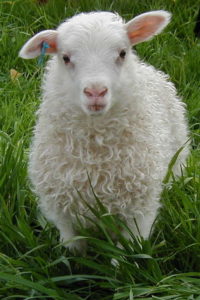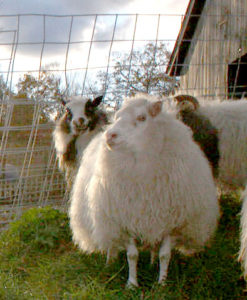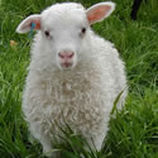
Your Icelandic Sheep: Lambing for the first time
Recently a shepherd who will have lambs for the first time emailed me about advice for lambing season, supplies and some advice to help him be ready. After writing back to him, I thought there might be some help in that email for other new and not so new shepherds.
It is getting on to the time to think about lambing. Attached is my “lambing supply list” (click here). I always have my well worn copy of Laura Lawson’s Managing Your Ewe and Her Newborn Lamb, the blue book, in the barn with me. Even though this will be our 23rd lambing it is my favorite reference and it has saved many lambs over the years. A good source of supplies is Pipestone Vet supply, they are online and the paper catalogue is a great source of information as well as supplies. I am a “hands on” sort of shepherd at lambing time. I like to be in the barn with the ewes and check on them frequently when I know they are due. I make night barn checks at least every 3 hours; it is not that they can’t lamb without me, I just like to be around. You will find many shepherds with much more “let them just do it alone” sort of attitude, but if my ewes need a hand I want to be there, especially for first-timers.
We have a hanging scale and a lamb sling to weigh the lambs, it is useful information. After the lambs have been licked off and gotten to nurse (they need to nurse soon or they get cold and can’t nurse, *read and re-read the information about hypothermia it is critical*) they get the navel trimmed and dipped in iodine and weighed and given two squirts of Pipestone’s Baby Lamb Strength. It is my favorite source of vitamins and a bit of energy calories. Never ever hesitate to take a lamb’s rectal temperature…it tells you more about that lamb’s status than any other piece of information. When folks call me for advice the first thing I will ask is “what is the temperature?”

You will want a good lubricant for when you need to “check” a ewe internally to see what is going on….I really like J-lube. I use the powder and reconstitute it in a squeeze bottle of some sort,a dish detergent or shampoo bottle works well. I don’t use gloves, but that is an option. Read and re-read the information of lamb presentations…they can get tangled or be coming backwards etc. Catch one of your friendlier ewes and note how the hooves in front are positioned, bottom of feet down if legs are stretched out in from of her and the bottom of the back hooves are facing up when the back legs are straightened out behind her, feel how the knees flex in the front leg and the back leg…so if you have to feel a lamb in the uterus you will recognize front legs and back legs…a tip * if you have to do an internal examination, close your eyes while you are doing it, you can feel things better and visualize things better. Have a portable catch pen, I use two “premier panels” tied together that I can tie to a fence or gate and trap the ewe in there and close it making a sort of triangle pen that is small, that way if I am alone I can do an internal exam if needed. It isn’t often but if you need to know what is going on, being clean and gentle and doing an exam is far better than a dead lamb. You have first time horned ewes..ram lambs can have very big horn buds that get hung up on the pelvic bones and need help…or tangles twins or tight vulva tissues that the ewe is having trouble getting the first lamb out…if she has feet and nose showing and just pushing and pushing, giving her a little help with the first lamb is fine..she doesn’t have to be heroic and has nothing to prove, she will be a fine mom and the next lamb will come out easier!! No need to have an exhausted ewe. Most of the time things are just fine…..
 If it is cold I dry the lambs off with a towel after mom has had a chance to lick it…the licking stimulates lots of maternal responses and uterine contractions so she can deliver the twin if there is one. I wait for her to have a chance to nurse the lamb but sometimes they are obsessed with licking the lamb and keep turning around as the lamb just about gets to a teat…I give them 15 minutes, then take the lamb, milk a bit out of each teat to be sure the plug is removed and try to get it on a teat, even if I have to pin mom against a wall..not very graceful and usually they are fine, but a lamb with no milk is a dead lamb! Once they get a few good drinks it usually dawns on mom what this is all about. Some ewes are just great…they seem to have read the book..others need a little help to figure out the whole thing…first timers are just learning , just like first time human moms.
If it is cold I dry the lambs off with a towel after mom has had a chance to lick it…the licking stimulates lots of maternal responses and uterine contractions so she can deliver the twin if there is one. I wait for her to have a chance to nurse the lamb but sometimes they are obsessed with licking the lamb and keep turning around as the lamb just about gets to a teat…I give them 15 minutes, then take the lamb, milk a bit out of each teat to be sure the plug is removed and try to get it on a teat, even if I have to pin mom against a wall..not very graceful and usually they are fine, but a lamb with no milk is a dead lamb! Once they get a few good drinks it usually dawns on mom what this is all about. Some ewes are just great…they seem to have read the book..others need a little help to figure out the whole thing…first timers are just learning , just like first time human moms.
I make little pens—“jugs” for my moms and lambs—picking up the lambs and walking backwards slowly holding the lambs close to the ground so mom can see them, and lead her to the jug…she will want to go back to where she lambed if you go too fast…if she runs back, just bring the lambs back and start again. I do not pen up a ewe until after she lambs, they need to pick their place to lamb and have room to pace and dig. In the jug mom gets a bucket of warm water and Karo syrup or molasses and nice hay … do not give her a bunch of grain, she may bloat. Then I attend to the lambs as I described above and let them be. I will check them in an hour to be sure the lambs are full and warm if I have any doubts about mom or a lamb. To check to see if a lamb has nursed, put your thumbs on it’s spine and your fingers under the belly and jiggle the belly with your fingers…it should feel like a little water balloon if it is full…if in doubt check the lamb’s temperature. Little lambs sleep a lot…when they wake up…healthy warm lambs will stretch when they stand up.
Mentoring is important. I tell all the folks that have sheep from us…if you are worried, if you have a problem, call me…I am probably up anyway..it’s lambing season…call my cell phone, or message me.
As far as medications are concerned , ask your vet for prescriptions or for the meds…oxytocin, (it can be really important if there is no vet near you) and Bo-Se (here in New England there is no selenium in the soil). You will want some penicillin on hand. You will want to get some CD&T vaccine (Pipetstone or other vet supply) and be sure your ewes are vaccinated 4 weeks or so before lambing …you can vaccinate mid March and again at the end of March to be sure they are current..they need to make antibodies in the colostrum. The lambs are born with no immunities…they can absorb antibodies from the colostrum through their stomach lining in the first 12-24 hours of life.
Save that colostrum! Just a little reminder…when you have a ewe with plenty of colostrum, be sure to milk some into a container and freeze it. Colostrum is only produced for the first 24 hours after lambing, but is getting more dilute as each hour goes by. A mature ewe with a single lamb is a good choice for a colostrum source. After the ewe’s lamb has had a good belly full, milk off some for your freezer stash. I save the colostrum in small yogurt cups or small ziplock bags, or breast milk ziplock bags, labeled with the year. I have an “Udderly EZ “ milker…it is easy to use and really helpful if you have to get milk to feed a lamb, to save colostrum or later to milk the ewes for your own use. You can buy them online…well worth the money in my opinion. But it is not difficult to hand milk, into a container. Just easy for the ewe to kick it or knock you or the container over.
If you need colostrum for a lamb, you can simple defrost it and feed it by bottle or tube feeding, if necessary. Defrost the colostrum in its container in a bowl of warm water. Never microwave or boil the colostrum, as that will kill the antibodies in it that are so vital for a new lamb. You can save the colostrum for at least a year in a good freezer. Having some stashed away makes it less chaotic if you find you suddenly need some for a new babe.
A newborn lamb needs at least 80 cc’s (ml’s) per pound of body weight in the first 18 hours of life under fairly warm dry conditions, and about 90 cc’s per pound if it is cold, wet or windy and the lamb is outside. This means that an 8 pound lamb will need at least 20 ounces of colostrum in 18 hours. You want to divide the feedings so that the lamb is fed every 3-4 hours. If you are tube feeding, give only 20 cc’s per pound of body weight at each feeding.
So, save that colostrum! You can use up quite a lot on just one lamb.
Lots of stuff to think about,…email with questions, anytime. And, do know that you can always call me during lambing, in the day if is it not an emergency or anytime in an emergency. that is the mentoring part of the price of our lambs…you need a mentor, I did too.
![]()

